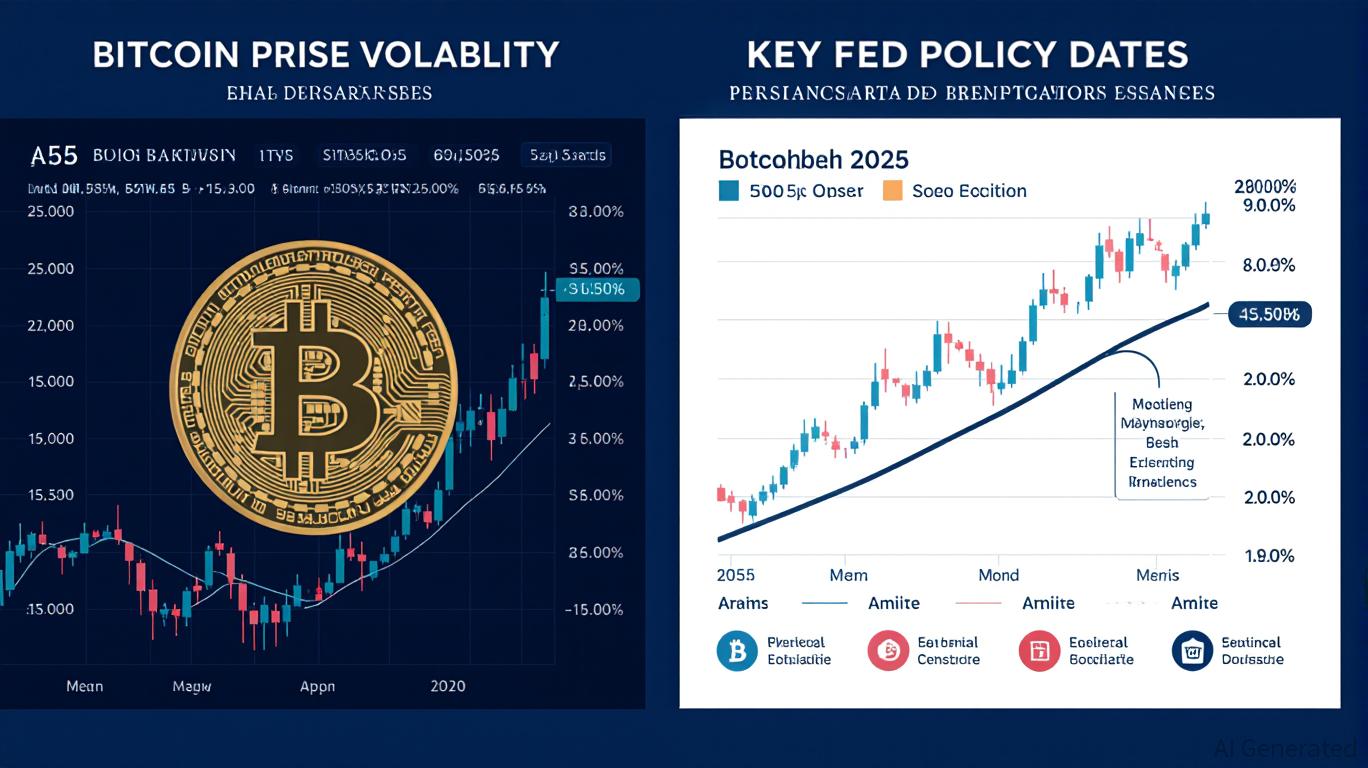Bitcoin Experiences Abrupt Price Swings as Global Economic Conditions Change: The Impact of Federal Reserve Actions and Regulatory Ambiguity on Cryptocurrency Values
- Bitcoin's 2025 volatility reflects Fed policy shifts and regulatory uncertainty, with price surging 86.76% amid rate cuts but sliding below $107,000 due to central bank ambiguity. - Regulatory developments like spot ETF approvals injected $4.21B in October, yet SEC delays and mixed global frameworks (e.g., EU MiCA vs. China's stability focus) create fragmented investor sentiment. - Institutional adoption grows (e.g., SoFi's crypto trading launch), but structural challenges persist, including miner losses
Fed Policy: Bitcoin’s Volatility Engine
The Federal Reserve’s approach in 2025 has been a central factor in Bitcoin’s price swings. At the start of the year, tight monetary policy—characterized by persistently high interest rates and a cautious outlook from Chair Jerome Powell—put downward pressure on riskier assets, including
Nonetheless, ongoing ambiguity from the Fed has created obstacles. Powell’s emphasis on “strongly differing views” regarding future rate reductions has left markets uncertain, with Bitcoin dropping below $107,000 in late October despite the start of rate cuts, according to
Regulatory Flux: Fuel for Growth and Instability
Shifts in regulation throughout 2025 have further intensified Bitcoin’s price fluctuations. The greenlighting of spot Bitcoin ETFs, for example, brought in $4.21 billion in new investments in October alone, pushing
At the same time, regulatory advancements in the U.S. have broadened access to Bitcoin. SoFi’s introduction of spot crypto trading in November 2025 was a landmark, enabling users to buy and sell Bitcoin and
Globally, the regulatory environment is fragmented. The EU’s Markets in Crypto-Assets (MiCA) regulation is nearing rollout, while China’s 2025 monetary policy continues to prioritize economic stability over crypto-specific changes, according to Gate. This divergence results in a complex regulatory landscape that complicates global investor confidence.

Macroeconomic and Regulatory Forces: At a Crossroads?
By the end of 2025, Bitcoin’s value is closely tied to the interplay between economic easing and regulatory transparency. ETF inflows have provided crucial support, but their impact depends on whether daily purchases surpass 2,500 BTC—a level associated with previous surges, according to Gate. On the other hand, structural issues remain: mining companies such as Bitdeer Technology Group, which posted a $266.7 million net loss in Q3 2025, illustrate the industry’s fragility amid higher costs and reduced rewards after the halving, as Gate notes.
Analysts believe Bitcoin’s next direction will be shaped by how these elements interact. If the Fed continues to focus on controlling inflation at the expense of growth, crypto demand could weaken. Conversely, regulatory alignment—such as the SEC’s efforts to clarify investment contract rules—could help steady investor sentiment, according to Gate. Additionally, Bitcoin’s price remains closely linked to broader economic indicators, such as the October inflation data, as Gate highlights.
Conclusion: Adapting to a New Era of Volatility
The turbulence seen in Bitcoin’s price throughout 2025 reflects its evolution from a speculative instrument to one increasingly influenced by macroeconomic trends. While central bank policy and regulatory changes are still key drivers, the crypto sector’s growing maturity—demonstrated by ETF launches and institutional participation—suggests that Bitcoin’s value may become less reactive to short-term disruptions in the future. For now, though, investors must contend with a market where every policy decision, regulatory announcement, and economic report can dramatically alter Bitcoin’s course.
Disclaimer: The content of this article solely reflects the author's opinion and does not represent the platform in any capacity. This article is not intended to serve as a reference for making investment decisions.
You may also like
Fed Focuses on Controlling Inflation Rather Than Boosting Economic Growth
- The Boston Fed urges delaying rate cuts until inflation nears 2% target, citing risks of premature easing in a still-inflationary environment. - Atlanta Fed's Bostic emphasizes inflation as the "clearer and more urgent risk" over labor market signals, reflecting hawkish policy divisions. - Fed officials consider resuming asset purchases post-October rate cut to maintain liquidity while avoiding inflationary spikes from tariffs. - Policy balancing act emerges: rate cuts could stimulate growth but risk rei
JPMorgan’s JPM Coin Connects DeFi with Conventional Banking in a $15 Trillion Initiative
- JPMorgan launches JPM Coin, a dollar-backed deposit token on Coinbase's Base blockchain, enabling instant institutional USD transfers. - Unlike stablecoins, JPM Coin leverages JPMorgan's regulated deposits with interest-bearing features, enhancing compliance and liquidity management. - The token aims to expand to euros and other blockchains, positioning JPMorgan as a leader in tokenizing bank liabilities amid global banking trends. - Regulators classify tokenized deposits as traditional assets, avoiding

Circle Introduces 'Economic Operating System' Through Arc's Native Token Debut
- Circle plans to launch a native token for its Arc blockchain to decentralize governance and boost adoption, replacing stablecoin-based gas fees. - Q3 2025 financials show 66% revenue growth ($740M) and 202% net income increase ($214M), contrasting with Q2's $482M loss from IPO costs. - Arc's public testnet (October 2025) attracted 100+ institutions including Goldman Sachs , aiming to become open infrastructure for tokenized finance. - The token aligns with industry trends toward scalable, cost-efficient

DASH Aster's DEX Launch: Ushering in a New Era for On-Chain Advancements and DeFi Integration
- DASH Aster's DEX combines AMM-CEX architecture with yield-collateral models, driving DeFi adoption through institutional-grade liquidity and 5-7% staking yields. - Cross-chain interoperability across BNB Chain, Ethereum , and Solana enables seamless asset transfers, boosting $12.9B cumulative trading volume and $17.35B TVL post-TGE. - Institutional validation from Binance's CZ and Coinbase's listing roadmap, alongside 30% price surges and 800% volume spikes, solidifies market credibility. - Tokenomics of
